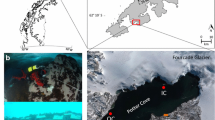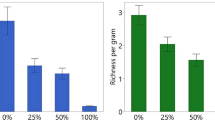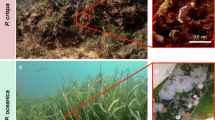Abstract
The utility of artificial habitats as tools in benthic studies was assessed by comparing the faunas associated with natural and artificial plants in a Japanese Sargassum bed. The 35 most common epifaunal species collected were all found to associate with both artificial and natural habitats, however, the abundances of species varied considerably between habitats. Colonization of artificial habitats was most rapid between 8 and 24 days after being placed in the field. This increased rate of colonization at intermediate time periods possibly reflected increasing attractiveness of habitats as a periphytic coating developed after the first week. Artificial habitats preconditioned in a sunlit environment to possess a layer of epiphytic algae attracted much higher numbers of epifaunal animals than habitats placed in a darkened but otherwise similar preconditioning environment. Epifaunal species appear to be attracted to artificial substrata, and presumably also natural habitats, largely because of associated diatoms and epiphytic plants.
Similar content being viewed by others
References
Aoki, M., 1988. Factors affecting population fluctuations of caprellid amphipods inhabiting Sargassum patens bed (preliminary report). Benthos Res. (Bull. Jap. Assoc. Benthology) 32: 42–49.
Aoki, M. & T. Kikuchi, 1990. Habitat adaptations of caprellid amphipods and the importance of epiphytic secondary habitats in a Sargassum patens bed in Amakusa, southern Japan. Publ. Amakusa Mar. Biol. Lab. 10: 123–133.
Bedford, A. P. & P. G. Moore, 1984. Macrofaunal involvement in the sublittoral decay of kelp debris; the detritivore community and species interactions. Estuar. Coast. Shelf Sci. 18: 97–111.
Duffy, J. E., 1990. Amphipods on seaweds: partners of pests? Oecologia 83: 267–276.
Edgar, G. J., 1983a. The ecology of south-east Tasmanian phytal animal communities. I. Spatial organization on a local scale. J. exp. mar. Biol. Ecol. 70: 181–203.
Edgar, G. J., 19836. The ecology of south-east Tasmanian phytal animal communities. IV. Factors affecting the distribution of ampithoid amphipods among algae. J. exp. mar. Biol. Ecol. 70: 205–225.
Edgar, G. J., 1990a. The influence of plant structure on the species richness, biomass and secondary production of macrofaunal assemblages associated with Western Australian seagrass beds. J. exp. mar. Biol. Ecol. 137: 215–240.
Edgar, G. J., 1990b. Population regulation, population dynamics and competition amongst mobile epifauna associated with seagrass. J. exp. mar. Biol. Ecol. 144: 205–234.
Ghelardi, R. J., 1971. Species structure of the animal community that lives in Macrocystis pyrifera holdfasts. Beihefte zur Nova Hedwigia 32: 381–420.
Hicks, G. R. F., 1977. Observations on substrate preference of marine phytal harpactacoid copepods. Hydrobiologia 56: 7–9.
Imada, K. & T. Kikuchi, 1984. Studies on some reproductive traits of three caprellids (Crustacea: Amphipoda) and their seasonal fluctuations in the Sargassum bed. Publ. Amakusa Mar. Biol. Lab. 7: 151–172.
Levinton, J. S., 1979. The effects of density upon depositfeeding populations: movement, feeding and floating of Hydrobia ventrosa Montagu (Gastropoda: Prosobranchia). Oecologia 43: 27–39.
Myers, A. A. & T. Southgate, 1980. Artificial substrates as a means of monitoring rocky shore cryptofauna. J. mar. biol. Assoc. U.K. 60: 963–975.
Norton, T. A. & M. R. Benson, 1983. Ecological interactions between the brown seaweed Sargassum muticum and its associated fauna. Mar. Biol. 75: 169–177.
Novak, R., 1984. A study in ultra-ecology: microorganisms on the seagrass Posidonia oceanica (L.) Delile. P.S.Z.N.I. Mar. Ecol. 5: 143–190.
Ruffo, A. R., 1990. The role of seaweed complexity in structuring Hawaiian epiphytal amphipod communities. Hydrobiologia 194: 1–12.
Schoener, A., 1974. Experimental zoogeography: colonization of marine mini-islands. Am. Nat. 108: 715–738.
Stephensen, K., 1933. Ceinina japonica (n.gen., n.sp.), a new aberrant species of the amphipodan family Talitridae from Japan. Trans. Sapporo Nat. Hist. Soc. 13: 63–68.
Tanaka, N., 1984. Distribution of attaching microalgae in Ago Bay — with special reference to genus Cocconeis and Synedra. Bull. Nat. Res. Inst. Aquaculture 6: 59–64.
Virnstein, R. W. & M. C. Curran, 1986. Colonization of artificial seagrass versus time and distance from source. Mar. Ecol. Prog. Ser. 29: 279–288.
Author information
Authors and Affiliations
Rights and permissions
About this article
Cite this article
Edgar, G.J. Artificial algae as habitats for mobile epifauna: factors affecting colonization in a Japanese Sargassum bed. Hydrobiologia 226, 111–118 (1991). https://doi.org/10.1007/BF00006812
Received:
Revised:
Accepted:
Issue Date:
DOI: https://doi.org/10.1007/BF00006812




